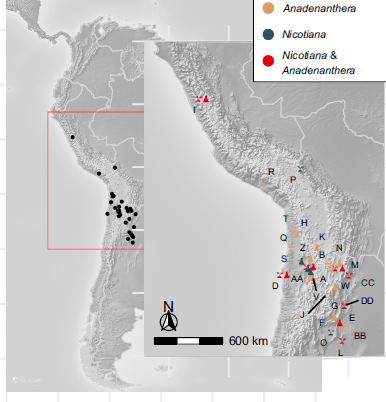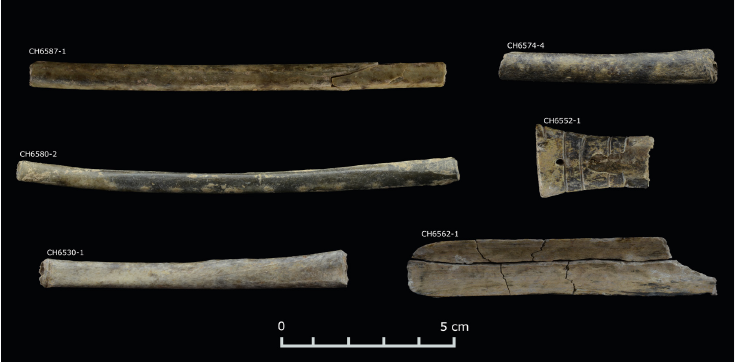Vilca or Cebil. Anandenandhera colubrina
Tello Obelisk, Chavín de Huántar, Peru
Chavin Culture, Andes, and throughout South America
Image 1. Tello Obelisk. Museo Nacional de Chavín de Huantar, Perú. (Sayre 2018, 270)
1. Name
Vilca or cebil is a South American psychoactive snuff powder containing the processed seed pods of the Anadenanthera colubrina tree, which is considered to resemble the Anadenanthera peregrina tree from which is made the Caribbean psychoactive snuff powder called yopo or cohoba. The main psychoactive principles in vilca are bufotenine and N,N dimethytryptamine (DMT). A regional powder called vilca tawri includes the seeds, edible beans, of Andean Lupinys mutabilis, known as maca, macay.Indigenous names in addition to vilca and cebil include aimpa, hatax, and kuripai. (Torres & Repke 2006). Cultural uses of vilca are associated with divination performed through consuming the snuff powder. Its therapeutic properties expel sickness, especially respiratory illnesses, and also function as an expectorant, balance humors, and treat cholera.
In Quechua and Aymara languages, the word vilca signifies sacredness, and it is related with other cultural features, such as toponyms. The Dictionary of the Aymara language: First and Second Partscompiled and published in Lima ca 1612 explains: “Villca: The sun as it is was said in antiquity and now they said inti . . . Villca: Shrine dedicated to the sun and other idols . . . Villca is also a medicinal thing, or thing given to drink as a purge, for sleeping, and in the sleep would come the thief who had taken the estate belonging to the one who drank the purge, and recover his state; it was a sorcerer´s deception.” (Torres & Repke 2006)
2. Introduction and Artwork
Iconographic analysis of phytomorphic (plant imagery), zoomorphic (animal imagery), and anthropomorphic (human imagery) motifs in the Tello Obelisk suggests the ritual use of psychoactive plants within the Chavín Culture during the Early Horizon phase (1200-500 BCE). The main motif in the Tello Obelisk is a zoomorphic figure identified with a crocodile or caiman. From the bottom left the iconographic analysis by Mulvany de Peñaloza (1984) highlights a zoomorphic representation perhaps a Vizcacha de la Sierra (Lagidium viscacia) and from its mouth comes a phytomorphic representation, probably a of Brugmansia .
In the posterior extremities just in the middle left side, there are two depictions of a zoomorphic head clearly distinguished by the claws and eyes. Just in the middle another zoomorphic being. From its mouth comes a phytomorphic representation with three elements, which resembles the form of an “enlarged S” in vertical disposition. Due to its morphology probably represents pod shaped fruits, perhaps Anadenanthera colubrina seeds from a cross cutting perspective. All of them are related with an anthropomorphic head from whose mouth and nostrils three elongated elements emerge.
Moving forward to the Center there are feline and supernatural beings; just in the center is possible to see two phytomorphic depictions. Both motifs feature an inverted L-shape design, which is topped with an anthropomorphically head, probably a personhood. Peñaloza argues that both represent a secondary stem of the San Pedro cacti. Summarizing that analysis also reveals Anadenanthera colubrina (Vilca) and Trichocereus pachanoi/Echinopsis pachanoi (Wachuma or San Pedro cacti), could be represented here and both are plants having psychedelic properties. Just in the center a personhood of a shell with eyes and teeth is clearly distinguishable. Moving to the right the big head of an alligator and depictions of a jaguar and a bird are in the right side of the image.
Though Peñaloza’s hypothesis was initially considered speculative without sufficient archeological evidence, recent research on material culture supports Peñaloza’s findings, providing direct evidence for the use of Anadenanthera colubrina in the Andean region and among the cultures that created the Tello Obelisk. Plants with psychedelic properties were used by the Chavin people in institutionalized rituals, and the plants were not limited to individualized contexts of ecstatic shamanism. (Rick et al 2025)
3. Geographical distribution
Anadenanthera colubrina or vilca is a species thriving south of the equator. Active ritual use is documented throughout the Central and Northern Andes. Anadenanthatera colubrina was cultivated and traded widely across the Americas, and not exclusively by those that refer to it as vilca, affirming its importance in ritual and healing practices across regions and cultural traditions. (Sayre 2018, 281) The word vilca is widely used as a plant and name for the psychoactive snuff, but it is a toponym. The Anadenanthera colubrina tree can be found in Paraguay, Bolivia, and Peru, reaching as far north as the Marañon valley on the Andes western slopes. (Torres and Repke 2006) It is found throughout Argentina’s Puna region and in the northern Argentinian provinces of Salta, Jujuy, Catamarca, Tucumán, and Misiones.
4. Primary Sources
The first historical literary reference describing the psychoactive properties of vilca was made by Polo de Oldegardo in 1571. (Torres & Repke 2006) Ritual use as a snuff powder was described in the southern Andean region in 1580 by the Spanish chronicler Cristobal de Albornoz. Archeological evidence suggests ritual use of Anadenanthera colubrina or vilca starting 4500 years ago in the Puna region of northwest Argentina. Evidence is found for vilca use as a snuff powder and as an inhaled smoke. Found in caves, ceramic smoking pipes contain vilca seeds in their bows and bends. Snuff tables and snuff pipes/tubes were discovered in the Atacama desert in Chile, west of the Andes. (Schultes, Hoffman and Rätsch 1992,120). Six important artifacts made of bird bones and containing chemical and microbotanical traces of psychoactive plants including as Nicotiana rustica and Anadenanthera colubrina, i.e., vilca, were recently discovered in Chavin de Huantar in Perú, a the ceremonial center. (Rick et al 2025)
5. Interpretation
Chavin culture developed during the early formative period from 1200BC to 200BC developed the production and social organization, Chavin art was very influential mainly through their art, ceramic and rituals. Precisely institutionally uses Anadenanthera colubrina to ensure ritual efficacy and to increase the credibility of the hosts in these rituals, due to hierophanies produced by the ritual use of plants and cacti with psychedelic properties, which strengthened the power or ritual specialists and priests facilitating social differentiation. Rituals using vilca took place inside restricted spaces in monumental structures such as stelae, obelisks and buildings that display specific iconography regarding supernatural beings and lore such as found at Chavin de Huantar, a major center of public ritual activity. Privileged access for Chavin people included entering and using these restricted, sacred spaces, active participation in ceremonies, and the ritual use of psychedelic substances that allows communication with sacred forces and supernatural beings.
6. Implications
The oldest archeological evidence for the ritual use of Anadenanthera colubrina is found in northwestern Argentina. Ceramic pipes found in caves there suggests vilca has been smoked for 4500 years. It is still used today, making it perhaps the longest documented continued use of a sacred plant with psychedelic properties. Vilca or cebil is considered a gateway to a visionary world, but it is also a medicine and a symbol related to light and the sun, both in Northwest Argentina and in the Andean region. Vilca’s cultural significance is beyond the boundaries of a single culture, though this entry focuses on the Chavin people. At the ceremonial center of Chavin de Huantar in Peru, recent archeological findings highlight the significance of studying material culture to achieve solid evidence of the ritual consumption of plants with psychedelic properties, which had previously been considered only speculative but can now be assured as historical fact. Studying material culture is useful to avoid hasty generalizations or incomplete speculation regarding the different cultural uses of Anadenanthera colubrina.
References:
Penaloza, E. Mulvany de. “Motivos fitomorfos de alucinogenos en Chavin.” Chungara 12 (1984): 57-80.
Rick, J. W., Lema, V. S., Echeverría, J., Valverde, G. A., Contreras, D. A., Arias Espinoza, O., Rosenfeld, S. A., & Sayre, M. P. “Pre-Hispanic ritual use of psychoactive plants at Chavín de Huántar, Peru.” Proceedings of the National Academy of Sciences 122, no19, (2025) e2425125122. https://doi.org/10.1073/pnas.2425125122
Sayre, Matthew, P. (2018). “A synonym of Sacred: Vilca use in the Preconquest Andes.” In Ancient Psychoactive Substances, ed. Scott. M Fitzpatrick (University Press of Florida, 2018), 265-285. https://doi.org/10.2307/j.ctvx076mt.14.
Schultes, R.E, Hofmann, Albert and Rätsch. Plants of the Gods Their Sacred, Healing and Hallucinogenic Powers. (Healing Arts Press, 1992):120-123.
Torres, Constantino. M., and Repke, David. B. Anadenanthera: Visionary Plant of Ancient South America: (Haworth Herbal Press, 2006), 52-57.
Image sources:
Cosenza, Luciano & Moya, Eliana & Franco, María & Brea, Mariana & Prado, Darien. (2022). “Anatomía de la madera y el carbón de Anadenanthera colubrina var. Colubrina. (Leguminosae, Caesalpinioideae).” Darwiniana. 10. (2022):103-115.
Image 2. Anadenanthera colubrina var. colubrina. A, specimen from Urquiza Park, Paraná, Entre Ríos. B, trunk with mamelons. C, branch with leaves and fruits. D, detail of leaves and flowers. E, fruits. F, seeds. G, insertion of leaflets on the rachis. H, leaflet with closed reticulate venation. I, detail of hairy rachis and rachis. Scales: E = 45 mm; F, G = 10 mm; H, I = 1 mm. (Cosenza, et al, 2022) http://www.ojs.darwin.edu.ar/index.php/darwiniana/article/view/999/1248
Image 3. Pre-Hispanic use of Anadenanthera colubrina var cebil and Nicotiana in the Central and Southern Andes, microbotanical and chemical evidence. (Rick et al, 2025)
Image 4. Ritual paraphernalia containing chemical and/or microbotanical residues of vilca and/or Nicotiana. (Rick, et al, 2025)
Image 5. Anadenanthera colubrina (Vilca or Cebil) Observation © janetchambi. Source: https://www.inaturalist.org/observations/4400801
Image 6. Anadenanthera peregrina (Cohoba or Yopo). Observation by w_endoSource: https://www.inaturalist.org/observations/122547165





